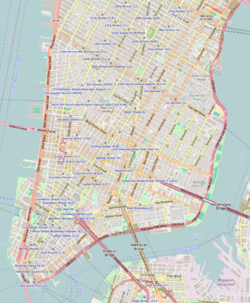House at 203 Prince Street | |
 | |
| Location | 203 Prince Street, Manhattan, New York City |
|---|---|
| Coordinates | 40°43′37″N74°0′12″W / 40.72694°N 74.00333°W |
| Built | 1834, expanded 1888 |
| Architectural style | Greek Revival, Federal |
| NRHP reference No. | 83001731 [1] |
| Significant dates | |
| Added to NRHP | May 26, 1983 |
| Designated NYCL | February 19, 1974 |
203 Prince Street is an historic townhouse on Prince Street between MacDougal and Sullivan Streets in the SoHo neighborhood of Lower Manhattan, New York City, United States. Built in 1834 with 2+1⁄2 stories on land that was once part of the estate of Aaron Burr, the house acquired an additional full story in 1888. [2] Primarily constructed in the late Federal style, the building also has elements of the Greek Revival style. [3] [4] [5]
Contents
The house was designated a New York City landmark in 1974, and was added to the National Register of Historic Places in 1983.



